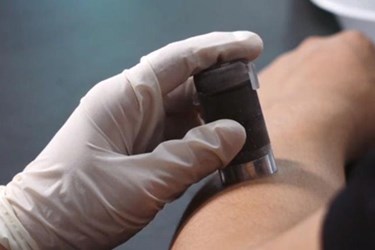College Freshmen Develop Single-Use Numbing Device To Lessen Injection Pain

Students at Rice University have created a device that uses ordinary coolants to numb the skin prior to an injection. The project targets both children and elderly patients who are susceptible to noncompliance due to the pain caused by needles.
A study published in the journal Vaccine surveyed both adults and children in Canada and found that 63 percent of children feared needle injections, and 8 percent cited fear as the primary reason for immunization noncompliance.
Researchers concluded that “access to analgesic interventions during immunization injections performed in childhood are recommended in order to prevent the development of needle fears and vaccine noncompliance.”
Now, a trio of college freshmen at Rice University have developed a single-use device prototype, which they named Comfortably Numb, uses the same technology available in ordinary icepacks to significantly reduce injection pain.
“Our device is 3-D printed and consists of two sealed chambers containing the chemical ammonium nitrate and water," first-year mechanical engineering major Mike Hua said in a Rice press release. "A simple twisting motion moves the chambers into alignment to allow the chemicals to flow through the chamber to produce a rapid endothermic reaction. We then numb the skin by contacting the device’s metal surface to the patient’s skin."
Their prototype was able to produce a measurable numbing effect within 60 seconds. According to researchers, comparative products such as a medicated coolant patch can take over an hour to start working.
“The materials for one of these cost about a quarter, and then we just had to do estimates based on how much manufacturing would cost. We compared our device to similar things already in production and we’ve estimated the cost at about $2,” said Zhang.
Though the device could be used by anyone, the team said that their target demographics are elderly and pediatric patients or patients receiving injections in sensitive areas of the body, such as the face or groin. Eventually, they said the device could even be adapted for use by ear piercing or tattoo artists.
“At the end of the day, what we’re creating is a self-contained device with a very cold contact surface, and there are many applications for that,” computer science major Greg Allison, the third member of the team, added.
Because the device is relatively inexpensive, the team has talked about adapting the technology to be used in the cap of a syringe for easy and convenient access by healthcare professionals.
The team is currently seeking a provisional patent for the device and is eager to continue perfecting their design for eventual marketing.
Much research has been dedicated to eliminating needle fear as an excuse for noncompliance, particularly in immunizations. Last year, the FDA approved PharmaJet injection technology, which administers a vaccine in one-tenth of a second, for the administration of the flu vaccine.
Image credit: Rice University
